This is one of the most common questions among dog parents that why do dogs have whiskers?
Have you ever looked at your dog’s cute little face and asked why do dogs have whiskers? Dog whiskers, scientifically known as vibrissae, are much more than extended body hair.
Some dog owners think it to be unkempt and ignorantly snip it off, but doing so can make your dog less spatially aware.
Dog whiskers are extra sensory receptors that help navigate the world before them.
In this article we answer all the questions regarding dog whiskers with some fun trivia!
Table of Contents
What Are Dog Whiskers?

Whiskers are long, coarse hair that sticks out from their snout, chin, and eyebrows. A dog’s mouth is rich in Merkel cells which makes tactile sensation possible. Merkel cells are specialized skin receptors that send sensory information to the dog brain.
Even though they are known as tactile hair, they don’t have any sensation. It is the neuron at the bottom of every whisker which is sensitive to touch and give a neural response to the brain.
Unlike their body hair, the follicles of this hair are full of sensitive nerves. It helps them to get an awareness of their surroundings. We can feel someone standing behind us, similarly, dog whiskers help them to get a spatial awareness but at a lower level.
There is a saying that a dog can apprehend a mishap way before it occurs. The nerves attached to it send signals of a slight change in the air, allowing them to measure the size, shape, and distance of the object. They are sensitive enough to pick up on ground vibrations and impending danger.
Why Do Dogs Have Whiskers?

Dog with whiskers is very sensitive to change in the air stream and important receptors of information about nearby objects. Your dog will be the first one to locate a fly in the room and will snap at it even before you can comprehend what happened.
Dogs don’t have the strongest vision so they entirely depend on the signal of their whiskers. As soon as there is a little movement, dog whiskers trigger the nerve which in turn sends signals to the brain. Remember the times when your dog stares at the void and starts barking for no particular reason? – his whiskers see more than your eyes can ever.
Dog whiskers can also do accurate calculations for fitting in a small space.
My dog can do better math than me. Life’s a joke!
Whiskers around their eyes are even smarter. When something touches the tip of their eye whiskers, it causes them to blink. This keeps harmful physical elements from getting in their eyes thereby preventing eye infections.
Whiskers are one of the early developing body hairs and go three times deeper under the skin. These help your puppy not just to understand the difference between shelter and home, but also further steers his cruise.
Interestingly, even hairless breeds of dogs have whiskers. They may not have fur but they will have a normal quota of whiskers.
Dog Whiskers Have Different Names

Weird and very scientific but dog whisker names are surely fun. They have a different name for every place that they are located.
- Those long horizontal ones that sprout out from the muzzle are known as “mystacial whiskers” because they resemble a mustache.
- The ones that come out straight from your dog’s cheek end are known as “genal whiskers”. It helps them locate objects on slightly back-side.
- If you brush your hands against his chin, you will feel moles-like spot hosting chin-whiskers. They are known as “interramal tufts”.
- Almost forget the one above his eyes. Known as “extended lashes” or “supraorbital whiskers”, it protects your dog’s eyes.
What Do Whiskers Do?
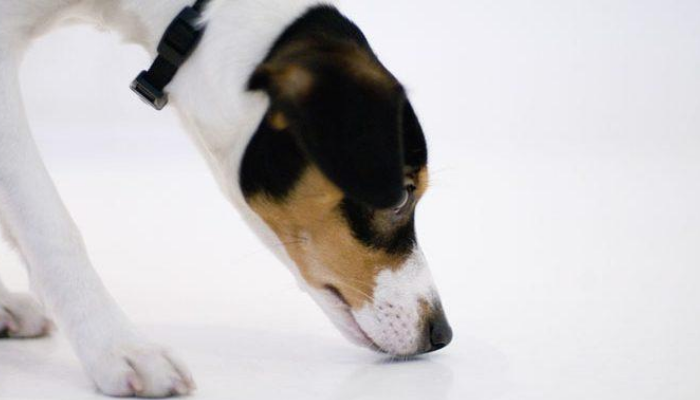
Hunting
Studies have claimed the chances of dogs using whiskers to locate food sometime in canine history. However, modern more domesticated dogs do not need to hunt food but it still helps them to trace that one drop of chocolate syrup which fell somewhere under the table and lick it clean.
Whiskers are present in a lot of mammals including seals and rats. Some dog breeds have also been known to use whiskers like other animals do – to hunt. Dogs have the bloodline of wolves that were known to be the best predators. Thanks to whiskers, dogs have long been a jolly company for hunters.
No wonder my dog got a dead duck home the other day.
Ernest Hemingway (American author), though known for his cats, had a pet dog named “Black Dog” (pun intended). He was known to accompany Hemingway, every time he went of Sport-Hunting.
Whiskers Conveying Emotions
Surprisingly, dog whiskers can reflect how their emotions. When at rest, your dog’s whisker would be relaxed. When afraid, it will sweep back, sometimes, as close as the cheeks. When angry, hunting, or alert, it will stand out straight. When your dogs feel threatened, he will flare his whiskers, pointing them forward. This signals other dogs or predators that the dog is ready to defend himself and fight back. Whiskers play an important part in canine’s combative strategy.
So, if there is a female dog around your buddy, try to look for the whiskers.
The Underworld
Turn out it is not just cars that have blind spots, dogs too have blind spots under. If your dog cannot locate a treat right under his nose, it is either because the color does not stand out against the background or it has fallen on their blind spot. That’s when their chin whiskers come in action. It helps them locate things right under their nose. It also helps your dog understand how close or far his food or water bowl is from his mouth, especially in the dark.
Dogs like Husky and Dachshund who have zeal towards digging and adventure use their under-chin whiskers to sniff and make a sense of the ground.
The Shield
Dog whiskers above their eyes play a protective role in their eyes. Dogs are prone to eye infections and a little carelessness can cost a lot. Imagine your dog is in the garden exposed to the possibilities of him getting injured by thorns, sticks, twigs, or pollens for that matter – supraorbital whiskers (the one above his eyes) acts as a shield. It protects the dog’s eye but triggering his senses as soon as there is a potential threat.
These whiskers also help dogs understand the direction of the wind while using their sense of smell to follow his prey or the toy that you threw.
You may notice that when you pet your dog’s head, he instantly closes his eyes. This is known as “blink reflex” which protects his eye from getting accidentally poked by your finger.
Heh! And you thought he was enjoying your pat? He was just defending himself from you without hurting your feelings. Nature and its ways.
Can You Cut Dog Whisker?
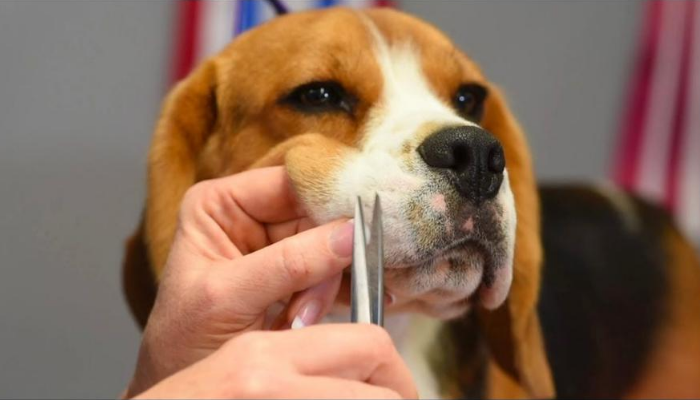
To trim or not to trim – that is the question. Not unless you want to make a boo-boo out of your dog in front of your guests. Some dog groomers trim dog whisker for aesthetics but we advise you do not snip it. Dog whisker can be unkempt and look extremely disordered but it serves an important purpose.
If you cut your dog’s whisker, it will make them less spatially aware and might start getting confused. It can affect their ability to judge and calculate when an object or threat is impending making him low on confidence.
Thought pet owners who take their dogs who show rings trim their vibrissae purely for cosmetic purposes, there are times when your dog might need trimming of whiskers for medical reasons. Trimming can be necessary for dogs that have long whiskers to avoid pricking the eyes.
Do Dog Whiskers Grow Back?
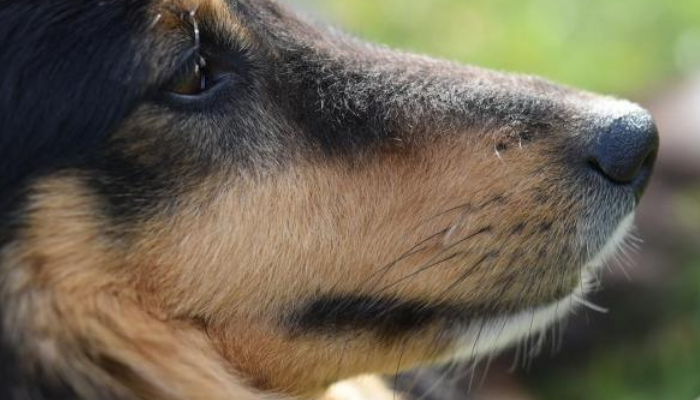
Do dog whiskers grow back? – A question every pet parent wants an answer to. As short as it can be – Yes!
Dog whiskers grow back but cutting it every time it grows back can cause permanent damage to it.
Cutting dog whiskers may not be painful and can make your dog look handsome but whiskers are not for their looks. They are their sixth sense and provide additional information to their brain. So, unless you have a show dog, it is advisable that even though dog whiskers grow back DO NOT CUT THEM.
Did you know?
Out of all the areas the brain invests in registering tactile information, 40% is dedicated to the dog’s facial area.
Dog Whisker Care
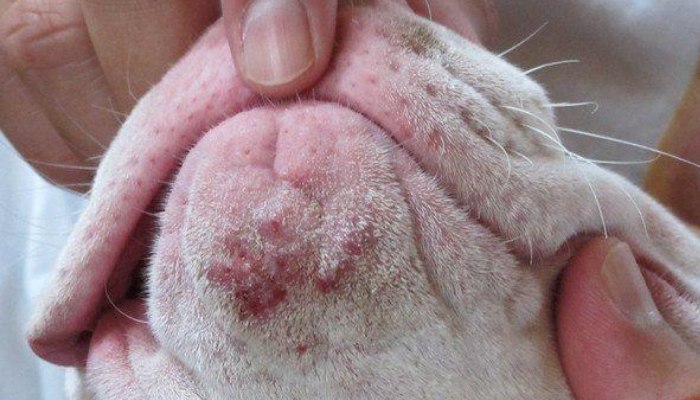
Dog Whisker Moles
Dogs are prone to whisker moles especially on dogs with darker pigmentation and it is not something to be concerned about. Scientifically known as sebaceous adenomas, they can appear due to prolonged exposure to the sun.
It is mostly found on the dog’s mouth or lower jaw. People consider it to be blemishes but in fact, they are just a collection of nerves covered with genetically inherent coats (like in German Shepherds).
Ingrown Dog Whiskers
Skinfold pyoderma can lead to ingrown hair which can lead to tissue irritation or bacterial infection.
Improper trimming of the vibrissae can also lead to ingrown hair. Sometimes, dead skin clogs a hair follicle that forces the whisker to grow sideways under the skin. It may cause inflamed bumps on the skin, itching on the skin or infected hair can also form pus cyst.
You can’t prevent ingrown hair completely but you can help reduce the risk of infection by letting the groomer do his job. Additionally, stop cutting dog whiskers unless the vet prescribes
Dog Whisker Pimple
Pimple can also be a cause of ingrown hair. You may notice sudden outbreaks especially under your dog’s chin and it is fairly common.
If it is acne, clean that area every day with warm water and a cotton swab.
Make sure your dog does not put his chin directly on the floor to avoid the worsening of pimples.
Continue this process for a few days and once your dog grows back his whiskers, it will get back to normal.
It looks similar to bumps and sometimes you cannot differentiate between acne and bumps. However, if it is causing your dog irritation, you should take him to the vet to find out the root cause.
Dog Whisker Infections
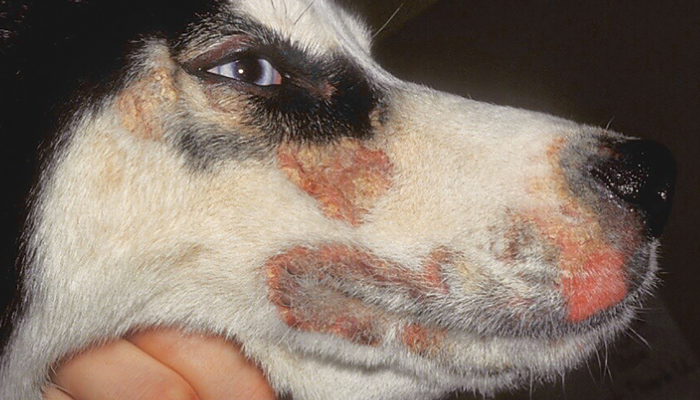
Folliculitis
Folliculitis is inflammation of one or more hair follicles. It generally happens due to infection of hair follicles with bacteria and is a common canine skin disease.
Symptoms can be reddish swellings on the skin, darkening of the skin, hair loss in the particular area, or superficial eruptions.
Treatment may be topical therapy through antimicrobials shampoos or systematic therapy through antibiotic medication.
Pyoderma
Pyoderma means “pus skin”. It can be caused by infection, inflammation, ingrown hair, or cancer and is a common canine infection.
Common symptoms can be pus-like bumps, itching, bald patches, or inflammation.
Most general treatment is an antibiotic medication for almost 3-4 weeks. As soon as you see these symptoms, take your dog to the vet.
Note: Dog with superficial pyoderma or folliculitis should be bathed with a shampoo recommended by the vet.
Dogs With Long Whiskers

There are a lot of breeds that have long whiskers. These breeds particularly need trimming of whiskers because they may be prone to pricking or ingrown hair.
The size and density may differ from breed to breed. Nevertheless…
- Irish Wolfhound
- Dandie Dinmont Terrier
- Portuguese Water Dog
- Tibetan Terrier
- Affenpinscher Dog (Monkey Terrier)
- Pomsky Dog
- Border Collie
- Havanese Dog
- Bolognese Dog
- Brussels Griffon
- West Highland White Terrier
- Schnauzer
- Cairn Terrier
- Catalan Sheepdog
- Long-haired Collie
- Russian Black Terrier
- Pyrenean Shepherd
- Airedale Terrier
- Norfolk Terrier
- Pekingese
- Bichon Maltese
- Bearded Collie
- Bergamasco Shepherd
- Yorkshire Terrier
- Skye Terrier
- Maremma Sheepdog
- Soft-coated Wheaten Terrier
- Australian Terrier
- Little Lion Dog
- Shih Tzu
- Scottish Terrier
- Fox Terrier
- Coton De Tuléar
- Lhasa Apso
- Old English Sheepdog
Frequently Asked Questions
What happens when you cut off a dog’s whisker?
If you cut your dog’s whiskers, it can come in between your dog’s ability to make sense of his surroundings. It can reduce his spatial awareness and confuse his mind. They may end up bumping into things and injure themselves. Trimming dog whiskers can be stressful for them and they will take a lot of time to get back to their usual self.
What is the purpose of dog whiskers?
Dog whiskers are extra sensory receptors that send a message to the dog brain about his surroundings. It helps the dog navigate the world and makes him spatially aware. It also helps them apprehend an impending threat or danger.
Can you cut a dog’s whiskers?
No, we generally don’t cut dog whiskers because that can meddle with their spatial awareness and create confusion in their mind. Though trimming dog whiskers is not painful, it can hamper their basic instincts.
Do dogs like their whiskers touched?
Dog whiskers, unlike body hair, are very delicate. They are sensitive to human touch. So, if you touch your dog’s whiskers, he might flinch in response. Similarly, if you pat his head, he will close his eyes or blink. It comes as a reflex and makes his body alert for an impending threat.
Do dog whiskers fall out?
Yes! It is common for dog whiskers to fall out or splinter over time. But as long as it is happening naturally, they will grow back and they will never shed enough to leave them haywire. Whiskers have a growth cycle like other body hair and they tend to shed and grow according to their cycle.
However, it may become a problem if it is trimmed by your groomer or yourself.
Do dog whiskers grow back?
If you are wondering whether your dog’s whiskers will grow back then you don’t need to worry. The short answer is – yes! Dog whiskers grow back again naturally. However, make sure that you don’t go trimming again right after he grows new whiskers. It may permanently damage the growth.
Fascinating, isn’t it? That’s all that you need to know about dog whiskers.
Lets us know how you liked this article.
If you have any concerns or questions, you can reach out to us in the comment section below.
Share this article on Facebook and Whatsapp to surprise your friends with facts about dogs.
Subscribe to our YouTube channel and follow us on Instagram for more such content.
Happy Petting to You Guys!












